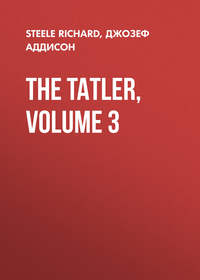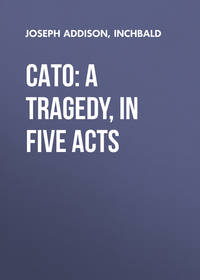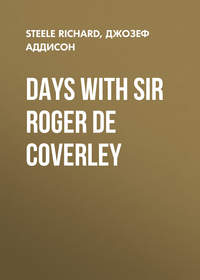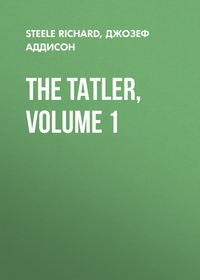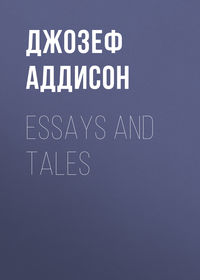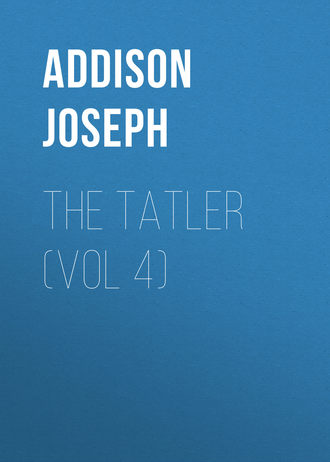 полная версия
полная версияThe Tatler (Vol 4)
90
"The so much-famed strops for setting razors, &c., are only to be had at Jacob's Coffee-house, in Threadneedle Street, with directions. Price 1s. each. Beware of counterfeits, for such are abroad. The trues ones, which deservedly have gained so much commendation, are only to be had as above. Golden snuff still to be had there, 6d. per paper" (Post-Man, March 23, 1703). Steele alluded twice to the author of "strops for razors" in the Spectator (Nos. 428 and 509). In No. 423 of the Spectator there was an advertisement of "the famous original Venetian strops." Swift, referring to rival imitations of the Tatler published in January 1711, says, "So there must be disputes which are genuine, like the strops for razors."
91
"Morning gowns of men and women, of silks, stuffs, and calicoes (being the goods of persons that failed), which were to be disposed of at the Olive Tree and Still, are now to be sold at the Golden Sugar Loaf, up one pair of stairs, over against the Horse, at Charing Cross; with a fresh parcel at very low rates, the price being set on each gown" (Tatler, No. 222). A similar advertisement from "the Black Lion, over against Foster Lane, Cheapside" (Examiner, December 7-14, 1710).
92
See No. 9. "The Scots Pills first made by Dr. Patrick Anderson, of the kingdom of Scotland, I John Gray do most faithfully and truly prepare, according to the doctor's method in his lifetime, and sell them as he sold them, that is, 5s. the whole box, 2s. 6d. the half box, 15d. the quarter box. Take notice, my pill has not that griping quality that is in the pill of a perpetual vain-boaster, whose pretended authority can never better the doctor's receipt who first invented them; the true knowledge whereof is in myself, as by my receipt, and further testimony of many famous doctors in this kingdom, it most plainly appears… These pills are sold at my house, the Golden Head, between the Little Turnstile and the Bull Inn, in High Holborn. Signed, John Gray"(Post-Boy, January 3, 1699). "Dr. Anderson's, or the famous Scots Pills, are (by his Majesty's authority) faithfully prepared only by J. Inglish, now living at the Golden Unicorn, over against the Maypole, in the Strand; and to prevent counterfeits from Scotland, as well as in and about London, you are desired to take notice, that the true pills have their boxes sealed on the top (in black wax), with a lion rampant and three mullets argent; Dr. Anderson's head betwixt J. J., with his name round it, and Isabella Inglish underneath it in a scroll" (Post-Man, January 9, 1700). "The right Scotch Pills, made by the heirs of Dr. Anderson in Scotland, are to be had of Mrs. Man, at Old Man's Coffee-house, Charing Cross" (Post-Man, October 23, 1703).
93
Dr. Clark, "sworn physician and oculist to King Charles and King James II.," advertised that his "ophthalmic secret" could be had from his house in Old Southampton Buildings, Holborn (Post-Man, August 24-26, 1710).
94
See No. 9.
95
"A noble electuary, which … makes the heart merry, restores, strengthens, and adds life, courage, and vigour to either men or women, to a miracle… Is to be had only at Mr. Spooner's, at the Golden Half Moon, in Lemon Street, in Goodman's Fields, at 5s. a pot, with directions" (Daily Courant, September 15, 1710).
96
"Ass's milk to be had at Richard Stout's, at the sign of the Ass, at Knightsbridge, for three shillings and sixpence per quart; the ass to be brought to the buyer's door" (Post-Boy, December 6, 1711).
97
This and other similar advertisements appeared in the Daily Courant for September 6, 1710.
98
"Whereas I, Michael Parrot, have had brought away a worm of sixteen feet long, by taking the medicines of J. Moore, apothecary, in Abchurch Lane, London; witness my hand, Michael Parrot. Witness, Anth. Spyer" (Post-Boy, April 27-29, 1710).
99
The True Spanish Blacking was advertised in opposition to "London Fucus for Shoes."
100
"An incomparable beautifying cream for the face, neck, and hands; takes away all freckles, spots, pimples, wrinkles, roughness, scurf, yellowness, sun-burning; renders the skin admirably clear, fair, and beautiful; has an excellent pretty scent; is very safe and harmless, and vastly transcends all other things; for it truly nourishes the skin, making it instantly look plump, fresh, smooth, and delicately fair, though before wrinkled and discoloured. Sold only at Mr. Lawrence's Toy Shop at the Griffin, the corner of the Poultry near Cheapside, at 2s. 6d. a gallipot, with directions" (Tatler, No. 140).
101
"Nectar and Ambrosia, the highest cordial in the world, being prepared from the richest spices, herbs, and flowers, and drawn from right brandy, comforting the stomach, immediately digesting anything that offends, cherishing the heart, fortifying the brain, and so cheers the spirits, that it makes the whole body lively, brisk, and vigorous. This is the cordial dram that the Czar of Muscovy so highly approved of. Sold in 1s. and 2s. bottles by some one person in many cities and county towns; and by wholesale by J. Hows, in Ram-head Innyard, Fenchurch Street, London" (Merlinus Liberatus; Partridge's Almanac for 1699).
102
"Twenty freehold tenements to be sold, lying in Wapping… Inquire at the Union Coffee-house, at King Edward's Stairs, in Wapping" (Tatler, No. 215).
103
"Anglia Notitia; or, The Present State of England," was begun by Edward Chamberlayn in 1669, and was continued for a number of years by his son, John Chamberlayn, who died in 1724.
104
"This day is published, 'Learned Annotations on the Tatler,' Part I. Printed for B. Lintott" (Daily Courant, August 31, 1710).
105
I cannot find any notice in the London Gazette or elsewhere of the bankruptcy of Bernard Lintott, who is no doubt here referred to. It almost seems as if Addison inserted the initials of the flourishing bookseller in retaliation for the publication by Lintott of the satirical "Annotations on the Tatler."
106
See No. 217.
107
See No. 14.
108
The Physician was one of the usurping Kings of Brentford.
109
See No. 34
110
"Livide" (Martial).
111
"Paradise Lost," iv. 358 seq.
112
Nos. 214 and 220.
113
"Next Tuesday morning will be published the account of the alterations of wind and weather, by the discoveries of the portable barometer; from what quarter the wind will blow, clouds or rain, wind and weather, clear and cloudy, wet and dry, come every day and night for the month of October, all over England, and also when the quicksilver weather-glasses will rise in wet, and sink in fair weather, and rise and sink without any alteration at all. Whereas there was a false impression of the last month, to the great damage of the author, who has been at vast charge and expense to being so useful an invention to perfection, and to prevent the like for the future, it is hoped that those ingenious persons who are lovers of so useful a discovery will not encourage the false one, the true one being only to be had at W. Hawes, at the Rose in Ludgate Street, and A. Baldwin in Warwick Lane, where they shall be sent to any gentleman, if desired, monthly" (Post-Man, September 26, 1700). These "barometer papers" are ridiculed in The Infallible Astrologer, a paper published in 1700.
114
This almanac was first published in 1663. The title of it was assumed in ridicule of Dr. Robert Pory, a pluralist of the last century, who, amongst other preferments (such as the archdeaconry of Middlesex, a residentiaryship of St. Paul's, &c.), enjoyed the rectory of Lambeth. Pory died in 1669, and "Poor Robin's Almanac" professed to bear his imprimatur (see Wood's "Fasti," Part II., col. 267).
115
No. 224.
116
Daniel Burgess (see No. 66).
117
The first number of Tit for Tat appeared under the name of Jo. Partridge, Esq., on March 2, 1710, with an announcement of Bickerstaff's death; probably it reached only to five numbers. Of the Whisperer (October 11, 1709), and the Gazette à-la-Mode, or Tom Brown's Ghost (May 12, 1709), only single numbers are known. The Female Tatler, issued by Thomas Baker, lasted from July 8, 1709, to March 31, 1710; and there was a rival paper, with the same title, printed for A Baldwin. The "New Atalantis," Mrs. Manley's well-known book, contained more than one attack on Steele. "Annotated" refers to the satirical "Annotations upon the Tatler," 1710 (see No. 224); and "condoled," to a pamphlet, "A Condoling Letter to the Tatler; on account of the misfortunes of Isaac Bickerstaff, a prisoner in the – on suspicion of debt" (September 19, 1710). The Tory Examiner had much to say about the Tatler and Steele's subsequent writings. Nothing is known of a Re-Tatler.
"For my part," wrote Defoe, "I have always thought that the weakest step the Tatler ever took, if that complete author can be said to have done anything weak, was to stoop to take the least notice of the barkings of the animals that have condoled him, examined him, &c. He should have let every bark and fool rail, and, according to his own observation of the fable of the sun, continued to shine on. This I have found to be agreeable to the true notion of contempt. Silence is the utmost slight nature can dictate to a man, and the most insupportable for a vain man to bear."
118
"Faërie Queene," 1. i. 22, 23.
119
See No. 239.
120
Swift was author of the letter which fills the remainder of this paper. See his "Journal to Stella," Sept. 18, 1710: "Got home early, and began a letter to the Tatler about the corruptions of style and writing, &c." Sept. 23, 1710: "I have sent a long letter to Bickerstaff, let the Bishop of Clogher smoke it if he can." Sept. 29, 1710: "I made a Tatler since I came; guess which it is, and whether the Bishop of Clogher smokes it." Oct. 1, 1710: "Have you smoked the Tatler that I wrote? It is much liked here, and I think it a pure one."
121
Thomas Harley, minister at the Court of Hanover, and cousin of Robert Harley, afterwards Earl of Oxford. He died in 1737.
122
This story is simply that of Katherine and Petruchio, in "The Taming of the Shrew," retold. It would seem that Steele was able to count upon his readers having very little knowledge of Shakespeare.
123
See No. 230.
124
See Nos. 155, 160, and 178.
125
Sacheverell's.
126
The Moderator, which professed to discuss the arguments of both parties impartially, lasted from May to November 1710.
127
No. 7 of the Examiner contained what purported to be a letter from a Swedish officer at Bender to his friend at Stockholm.
128
See Nos. 38 and 230.
129
This letter refers to the one by Swift in No. 230, on the corruptions of the English language in ordinary writings. The present letter, which is supposed to be by James Greenwood, closes with the statement that an English grammar, with notes, would be published next term. Soon afterwards there appeared, with the date 1711, "A Grammar of the English Tongue, with Notes… Printed for John Brightland," &c. This book was noticed in the Works of the Learned for November 1710. Facing the title is a page bearing the head of Cato the Censor, and the following lines: "The Approbation of Isaac Bickerstaff, Esq.: 'The following treatise being submitted to my censure, that I may pass it with integrity, I must declare, that as grammar in general is on all hands allowed to be the foundation of all arts and sciences, so it appears to me that this Grammar of the English Tongue has done that justice to our language which, till now, it never obtained. The text will improve the most ignorant, and the notes will employ the most learned. I therefore enjoin all my female correspondents to buy, read, and study this grammar, that their letters may be something less enigmatic; and on all my male correspondents likewise, who make no conscience of false spelling and false English, I lay the same injunction, on pain of having their epistles exposed in their own proper dress in my Lucubrations. – Isaac Bickerstaff, Censor.'" There is a Dedication to the Queen, and a Preface in which "the Authors" explain how they have come to undertake a much-needed work at the request of Mr. Brightland.
This book was followed by a pamphlet of six pages, "Reasons for an English Education, by teaching the Youth of both Sexes the Arts of Grammar, Rhetoric, Poetry, and Logic, in their own Mother-Tongue, 1711." On p. 5 the writer asks, "Has our Censor complained without cause, and given a false alarm of danger to the language of our country? (Lucubrat., Sept. 28, 1710);" and on the next page we are told that I. B., encouraged by the success of his book, was industriously correcting it for a second edition. This appeared in 1712, with an increase in the number of pages from 180 to 264. Other editions appeared in 1714 and 1720. The fifth is dated 1729, and is advertised in the Craftsman for July 5, 1729, as "recommended by Sir Richard Steele, for the use of the schools of Great Britain;" but according to the Monthly Chronicle, it really appeared on August 8, 1728, being called in the Index, "Bickerstaffe's Grammar." The seventh and eighth editions were published in 1746 and 1759.
In Nos. 254 and 255 of the Tatler there was advertised, as shortly to be published, "An Essay towards a Practical English Grammar, by James Greenwood… Particular care has been taken to render this book useful and agreeable to the Fair Sex." This book is dated 1711, and is noticed in the Works of the Learned for July. The Preface gives "part of a letter which I wrote about a twelvemonth ago to the ingenious author of the Tatler upon this head" (i. e. knowledge of grammar among the fair sex). Greenwood's remarks on female education were not printed in the Tatler; but they may have formed part of the letter in this number (234), if this letter is by Greenwood. The third edition, enlarged, of Greenwood's "Essay" appeared on May 24, 1729. Greenwood was sub-master at St. Paul's School, and afterwards kept a boarding-school at Woodford, in Essex. He published "The London Vocabulary, English and Latin," of which there was a third edition in 1713, with curious illustrations. By 1817 this book had passed through twenty six-editions in England, besides several in America. Greenwood also published in 1713 "The Virgin Muse," a collection of poetry for "young gentlemen and ladies at school." Second and third editions appeared in 1722 and 1731.
Michael Maittaire also issued, in 1712, "An English Grammar; or, an Essay on the Art of Grammar, applied to and exemplified in the English Tongue." In the same year a pamphlet appeared with the title, "Bellum Grammatical, or the Grammatical Battle-Royal. In Reflections on the three English Grammars published in about a year last past." It consists chiefly of an attack on Greenwood's "Essay," and praise of Brightland's "Grammar," which "merits what the Censor said of it." In a postscript Maittaire's "Grammar" is described as the worst of all. Brightland and Greenwood deserve to be remembered for their efforts to spread abroad a knowledge of "the genius and nature of the English tongue." (The facts in this note are taken from a paper by the present writer in Watford's Antiquarian for October 1885.)
130
Horace, 3 Od. iv. 19.
131
Virgil, "Eclog." i. 67.
132
Bartolus (a covetous lawyer). Where shall I find these sums? Diego (sexton to Lopez). Even where you please, sir."
– Beaumont and Fletcher's "Spanish Curate," Act. iv. sc. i.133
Nichols thinks that Addison was probably the author of this paper, because of the allusion to Addison's family at the close. But Steele had visited Dr. Lancelot Addison's home when he was a boy at the Charterhouse. The paper is not printed in Addison's works.
134
Addison's father, Dr. Lancelot Addison, Dean of Lichfield, had three sons: (1) Joseph; (2) Gulston, who died Governor of Fort-George in the East Indies; (3) Lancelot, who was entered in Queen's College, and afterwards became Master of Arts, and Fellow of Magdalen College in Oxford; and a daughter, Dorothy, first married to Dr. Sartre, formerly minister of Montpellier, and afterwards Prebendary of Westminster; and, secondly, to Daniel Combes, Esq. Swift wrote on October 25, 1710: "I dined to-day with Addison and Steele, and a sister of Mr. Addison, who is married to one Mons. Sartre, a Frenchman, prebendary of Westminster, who has a delicious house and garden; yet I thought it was a sort of monastic life in those cloisters, and I liked Laracor better. Addison's sister is a sort of a wit, very like him. I am not fond of her."
Addison had two other sisters, who died young. Of his brother Gulston we read thus in the "Wentworth Papers" (pp. 75-76): "Since I wrote this, I am told a great piece of news, that Mr. Addison is really a very great man with the juncto, and that he has got his elder brother, who has been a factor abroad in those parts, to be Governor of Fort St. George… It seems Mr. Addison's friends can do what they please with the chief of the East India Company, who, I think, have the liberty of naming their Governor, and by management with them this place is got, which they say some years is worth £20,000" (Peter Wentworth to Lord Raby, January 28, 1709).
135
In the Dedication to Congreve of Addison's "Drummer" (1722), Steele said, "Mr. Dean Addison, father of this memorable man, left behind him four children, each of whom, for excellent talents and singular perfections, was as much above the ordinary world as their brother Joseph was above them. Were things of this nature to be exposed to public view, I could show, under the Dean's own hand, in the warmest terms, his blessing on the friendship between his son and me; nor had he a child who did not prefer me in the first place of kindness and esteem, as their father loved me like one of them."
136
The authorship of the letter which forms the principal part of this number is unknown. Goldsmith was told that a Dean of Killaloe was the author of a paper in the Tatler or Spectator, but there is nothing to connect the Dean (Jerome Ryves) with this particular number.
137
This may apply either to Swift, from whom Steele borrowed the name of Bickerstaff, or to Steele himself.
138
"Our one horse vehicles have always been peculiar to ourselves, and were in use long before anything of a similar kind was introduced into England. The earliest and rudest of these were the Ring's End cars, so called from their plying principally to that place and Irishtown, then the resort of the beau monde for the benefit of sea-bathing. This car consisted of a seat suspended in a strap of leather between shafts, and without springs. The noise made by the creaking of the strap, which supported the whole weight of the company, particularly distinguished this mode of conveyance" ("Sketches of Ireland Sixty Years Ago," p. 77, quoted in Notes and Queries, 7th Series, iv. 178-179). Ring's End is a fishing village near Dublin.
139
Sir Hans Sloane. The hazardous voyage to Liverpool is, perhaps, an allusion to the doctor's voyage to Jamaica, ridiculed by Dr. William King, in "A Voyage to the Island of Cajamai."
140
For previous attacks on the Royal Society by Addison, see Nos. 119, 216, and 221.
141
Nichols thought this paper was written by Addison, or with his assistance. "The Tatler upon Milton's 'spear' is not mine, madam. What a puzzle there was between you and your judgment! In general you may sometimes be sure of things, as that about Style [Tatler, No. 230], because it is what I have frequently spoken of; but guessing is mine; – and I defy mankind if I please" (Swift's "Journal to Stella," Nov. 8, 1710).
142
"Paradise Lost," iv. 797-819.
143
"I am going to work at another Tatler" (Swift's "Journal," Oct. 4, 1710). "And now I am going in charity to send Steele another Tatler, who is very low of late" (Ib., Oct. 7, 1710). "I am now writing my poetical description of a 'Shower in London,' and will send it to the Tatler" (Ib., Oct. 10, 1710). "I have finished my poem on the 'Shower,' all but the beginning; and am going on with my Tatler" (Ib., Oct. 12, 1710). "This day came out the Tatler, made up wholly of my 'Shower,' and a preface to it. They say it is the best thing I ever wrote, and I think so too. I suppose the Bishop of Clogher will show it you. Pray tell me how you like it" (Ib., Oct. 17, 1710). "They both [Rowe and Prior] fell commending my 'Shower' beyond anything that has been written of the kind; there never was such a 'Shower' since Danae's," &c. "You must tell me how it is liked among you" (Ib., Oct. 27, 1710). "The Bishop of Clogher says, I bid him read the London 'Shaver,' and that you both swore it was 'Shaver,' and not 'Shower.' You all lie, and you are puppies, and can't read Presto's hand" (Ib., Nov. 28, 1710). "My 'Shower' admired with you; why the Bishop of Clogher says, he has seen something of mine of the same sort, better than the 'Shower.' I suppose he means 'The Morning'; but it is not half so good" (Ib., Nov. 30, 1710).
144
Altered in Johnson's "Poets," and other editions, to "old aches will throb"; otherwise "aches" must be pronounced as a dissyllable.
145
The Examiner, the eleventh number of which consisted of jibes against No. 229 of the Tatler, by Addison.
146
Sir Samuel Garth, who has attacked in the sixth number of the Examiner.
147
Bishop Atterbury. The verses were written "on a white fan borrowed from Miss Osborne, afterwards his wife."
148
The attack was, of course, on Steele, and consisted of allusions to sponging-houses and fears of arrest for debt. It will be remarked that No. 229 was really by Addison, who here nobly defends his friend.
149
Ovid, "Met." iii, 357.
150
Ars Poet. 309
151
Kirleus (see No. 14).
152
Saffold (see No. 20, note) is said to have been originally a weaver. Afterwards he told fortunes, and practised as a quack doctor. A satirical "Elegy on the Death of Thomas Saffold, who departed this life, May 12, 1691," was published after his death.



